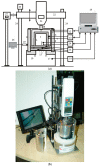Measurement Methods of the Thermal Resistance of Materials Used in Clothing
- PMID: 37241469
- PMCID: PMC10224179
- DOI: 10.3390/ma16103842
Measurement Methods of the Thermal Resistance of Materials Used in Clothing
Abstract
This paper describes methods for evaluating the thermal properties of textile materials, clothing composites, and clothing using an integrated measurement system that includes a hot plate, a multi-purpose differential conductometer, a thermal manikin, a temperature gradient measurement device, and a device for measuring the physiological parameters of the human body during the exact evaluation of garment thermal comfort. In practice, measurements were taken on four types of materials widely used in the production of conventional and protective clothing. The measurements were carried out using a hot plate and a multi-purpose differential conductometer, determining the thermal resistance of the material both in its uncompressed form and when a force was applied that was ten times greater than that needed to determine its thickness. Using a hot plate and a multi-purpose differential conductometer, thermal resistances of textile materials were assessed at different levels of material compression. On hot plates, both conduction and convection had an impact on thermal resistance, but in the multi-purpose differential conductometer, only conduction did. Moreover, a reduction in thermal resistance was observed as a result of compressing textile materials.
Keywords: clothing; hot plate; multi-purpose differential conductometer; textiles; thermal resistance.
Conflict of interest statement
The authors declare no conflict of interest.
Figures







References
-
- Su Y., Fan Y., Liu G., Tian M., Li J. A Review on Sustainable Method to Evaluate Heat and Moisture Transfer in Clothing Material. Sustainability. 2023;15:2747. doi: 10.3390/su15032747. - DOI
-
- He H., Qin Y., Liu J., Wang Y., Wang J., Zhao Y., Zhu Z., Jiang Q., Wan Y., Qu Y., et al. A wearable self-powered firewarning e-textile enabled by aramid nanofibers/MXene/silver nanowires aerogel fiber for fire protection used in firefighting clothing. Chem. Eng. J. 2023;460:141–661.
-
- Cherunova I., Kornev N., Lukyanova E., Varavka V. Development and Study of the Structure and Properties of a Composite Textile Material with Encapsulated Heat-Preserving Components for Heat-Protective Clothing. Appl. Sci. 2021;11:5247. doi: 10.3390/app11115247. - DOI
Grants and funding
LinkOut - more resources
Full Text Sources

